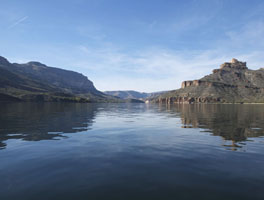December 12, 2012 – via the Bureau of Reclamation
 WASHINGTON, D.C. – Secretary of the Interior Ken Salazar today announced the release of a study – authorized by Congress and jointly funded and prepared by the Bureau of Reclamation and the seven Colorado River Basin states – that projects water supply and demand imbalances throughout the Colorado River Basin and adjacent areas over the next 50 years. The Colorado River Basin Water Supply and Demand Study, the first of its kind, also includes a wide array of adaptation and mitigation strategies proposed by stakeholders and the public to address the projected imbalances.
WASHINGTON, D.C. – Secretary of the Interior Ken Salazar today announced the release of a study – authorized by Congress and jointly funded and prepared by the Bureau of Reclamation and the seven Colorado River Basin states – that projects water supply and demand imbalances throughout the Colorado River Basin and adjacent areas over the next 50 years. The Colorado River Basin Water Supply and Demand Study, the first of its kind, also includes a wide array of adaptation and mitigation strategies proposed by stakeholders and the public to address the projected imbalances.
The average imbalance in future supply and demand is projected to be greater than 3.2 million acre-feet by 2060, according to the study. One acre-foot of water is approximately the amount of water used by a single household in a year. The study projects that the largest increase in demand will come from municipal and industrial users, owing to population growth. The Colorado River Basin currently provides water to some 40 million people, and the study estimates that this number could nearly double to approximately 76.5 million people by 2060, under a rapid growth scenario.
“There’s no silver bullet to solve the imbalance between the demand for water and the supply in the Colorado River Basin over the next 50 years – rather, it’s going to take diligent planning and collaboration from all stakeholders to identify and move forward with practical solutions,” said Secretary Salazar. “Water is the lifeblood of our communities, and this study provides a solid platform to explore actions we can take toward a sustainable water future. While not all of the proposals included in the study are feasible, they underscore the broad interest in finding a comprehensive set of solutions.”
Authorized by the 2009 SECURE Water Act, the study analyzes future water supply and demand scenarios based on factors such as projected changes in climate and varying levels of growth in communities, agriculture and business in the seven Colorado River Basin states of Arizona, California, Colorado, New Mexico, Nevada, Utah, and Wyoming.
The study includes over 150 proposals from study participants, stakeholders and the public that represent a wide range of potential options to resolve supply and demand imbalances. Proposals include increasing water supply through reuse or desalinization methods, and reducing demand through increased conservation and efficiency efforts. The scope of the study does not include a decision as to how future imbalances should or will be addressed. Reclamation intends to work with stakeholders to explore in-basin strategies, rather than proposals – such as major trans-basin conveyance systems – that are not considered cost effective or practical.
“This study is one of a number of ongoing basin studies that Reclamation is undertaking through Interior’s WaterSMART Program,” said Assistant Secretary for Water and Science Anne Castle. “These analyses pave the way for stakeholders in each basin to come together and determine their own water destiny. This study is a call to action, and we look forward to continuing this collaborative approach as we discuss next steps.”
WaterSMART is Interior’s sustainable water initiative and focuses on using the best available science to improve water conservation and help water-resource managers identify strategies to narrow the gap between supply and demand. The WaterSMART program includes Reclamation’s Water and Energy Efficiency grants, Title XVI Reclamation and Recycling projects, and USGS’s Water Availability and Use Initiative.”This study brings important facts and new information to the table so that we can better focus on solutions that are cost effective, practical and viable” said Bureau of Reclamation Commissioner Mike Connor. “We know that no single option will be enough to overcome the supply and demand gap, and this study provides a strong technical foundation to inform our discussions as we look to the future.”
Spanning parts of the seven states, the Colorado River Basin is one of the most critical sources of water in the western United States. The Colorado River and its tributaries provide water to about 40 million people for municipal use; supply water used to irrigate nearly 4 million acres of land, and is also the lifeblood for at least 22 Native American tribes, 7 National Wildlife Refuges, 4 National Recreation Areas, and 11 National Parks. Hydropower facilities along the Colorado River provide more than 4,200 megawatts of generating capacity, helping meet the power needs of the West.
Throughout the course of the three-year study, eight interim reports were published to reflect technical developments and public input. Public comments are encouraged on the final study over the next 90 days; comments will be summarized and posted to the website for consideration in future basin planning activities.
The full study – including a discussion of the methodologies and levels of uncertainty – is available at https://www.usbr.gov/lc/region/programs/crbstudy.html.

